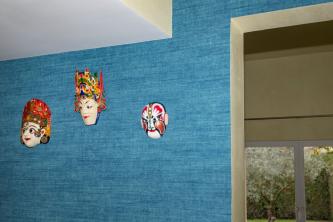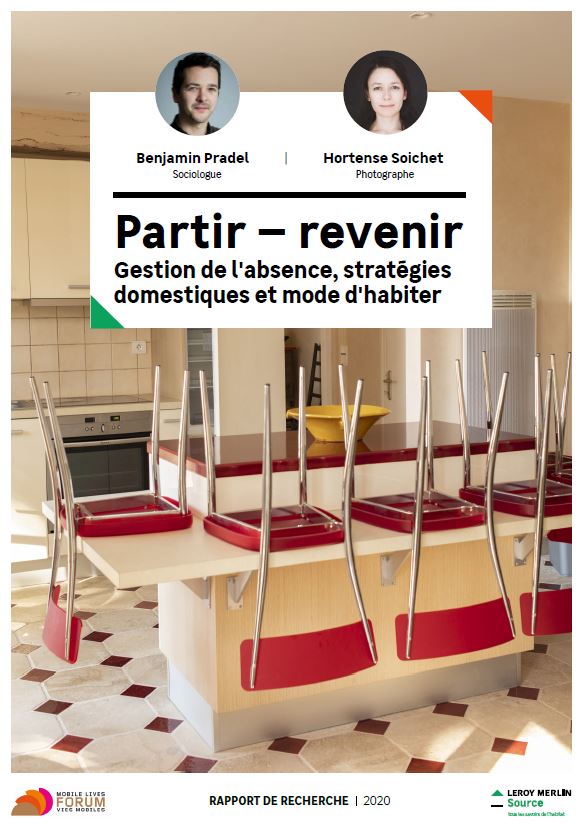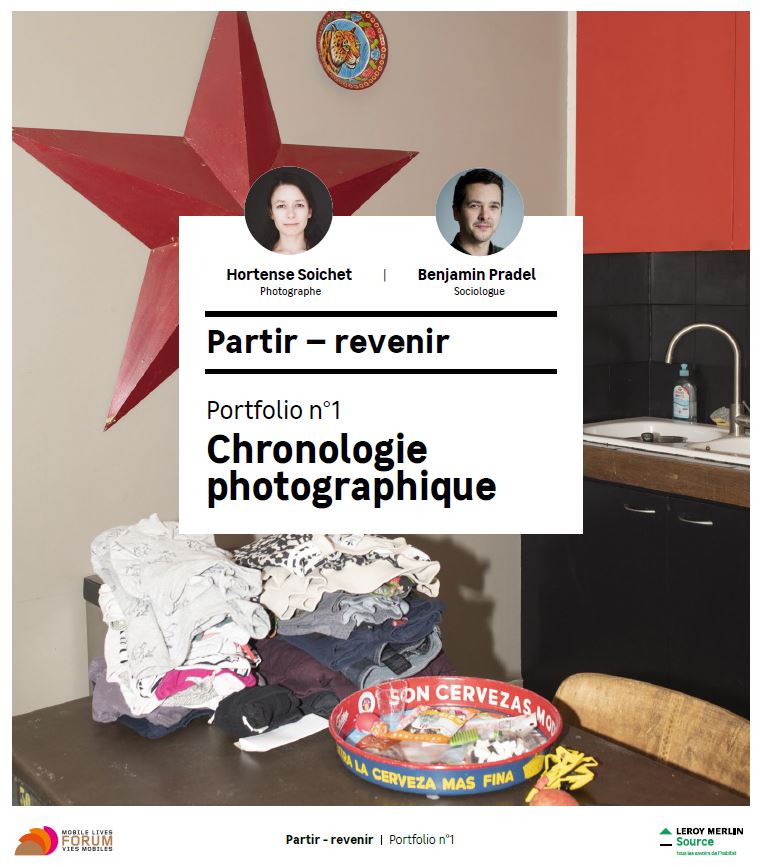
The “leaving and returning” project, combining the two themes of mobility and "dwelling", focuses on the temporary physical absence of people from their homes. What links do they maintain with their homes when they are on the move? What consequences do these mobilities have on the social and spatial organization of their homes? Being able to peacefully leave home and experience a pleasurable mobility depends on the individuals’ profile, their expectations with regard to their travels and a learning-curve that is almost a skill in its own right, in a world where travelling has often become the norm.
Managing one’s absence from home seems to have become a major issue in today’s so-called "hypermobile" society where individuals very often find themselves away from their home environment. Despite more and more people working from home and the development of long distance communication, some claim we’ve become a "society of ritualized absence" (Viard, 2014). This society, enabled by a greater mobility in terms of leisure and work, leads to more time spent away from home. In this context, being absent from one’s own home appears to be an emerging feature in contemporary ways of dwelling, based on specific social practices. Managing this absence influences the material organization of the home and more generally one’s relationships to the habitat - understood as the living environment that includes all local and social ties.
This research project, in collaboration with Leroy Merlin Source, focused on the temporary physical absence of people from their homes while they are being mobile, in order to study how people manage this absence and explore their attachment/detachment behaviors with regard to their home in the context of their mobility-related needs and habits.
It was hypothesized that the absence situation gives rise to specific social, spatial and temporal behaviors related to the organization, management and preservation of the home – whether the home in question has other occupants or not. Indeed, these behaviors are worth studying even if the house is still occupied when away from it, by another member of the household for instance or a sub-tenant. As such, these behaviors would contribute to a symbolic and material ownership of the home.
Several reasons may explain why people implement methods and devices for managing and even counteracting their absence from home:
These practices are not exclusive and work in conjunction, producing what we can call forms of "remote dwelling." People resort to two kinds of methods to manage their homes when they are away:
The goal was to analyze what their use and significance is in people’s relationship to housing and mobility. It is important to note that what is being observed here is one’s absence from a home that may or may not be otherwise occupied by other people. Indeed, it could be sub-rented or occupied by another member of the household. The idea remains to see how the absence of one of the occupants can produce specific dwelling behaviors. The project favored a multidisciplinary approach and created a dialogue between photography and sociology. Starting from the premise that people create an imaginary of their home when they are away from it through a situation of mobility, the goal here was to capture a trace of this through photography, to produce pictures to show the places and devices through which people remotely manage their homes, whether physically, socially or symbolically. Photography in this context also provided an opportunity to capture certain behaviors performed by the inhabitants that reveal how they manage their absence from home. The photography work was put into perspective with an analysis of how people behave and represent their homes when they are away, as reported in the sociological survey. The goal here was therefore to understand people’s representations of their homes when away from them and how their relationships to them drive the implementation (or not) of home management practices, to describe, categorize and contextualize them in connection to the kinds of movements that produce the absence.
The different modalities of absence and their associated representations lead to different ways of managing this absence and, ultimately, to different modes of remote dwelling. Hypothesis 1: The devices employed to manage one’s absence from home and their specific uses vary depending on the kind of trip made and especially how reversible it is. The frequency (in terms of routine), duration (in terms of time spent away) and distance (in relation to the home) of trips have an impact on the nature and use of these devices. Hypothesis 2: The devices employed to manage one’s absence from home and their specific uses vary depending on the type of dwelling: what kind of accommodation (house or apartment, size, configuration, etc.), surroundings (rural, suburban, urban, density, collective building, subdivision, etc.) and ownership status (is the person a tenant or co/owner, how long has he/she lived there, etc.). Hypothesis 3: The devices employed to manage one’s absence from home and their specific uses vary depending on localized social capital, i.e. people’s social networks in the spatial environment of their homes. Weak ties (neighbors, colleagues, acquaintances, etc.) and strong ties (family, friends, etc.) are resources that facilitate departures and absences from home.
This research project was conducted in partnership with Leroy Merlin Source. It was launched in June 2018.
To leave home with your mind at ease means being able, along the way, to divert your attention from home. It means not worrying too much about those who stay there, the activities that take place there, or the objects that remain. It means coping well with the distance from the domestic environment, in order to engage in one’s activities elsewhere (whether they are professional or personal), near or far, and to live them serenely and without disturbance. It means being able to come back home to one’s individual or shared habits and reclaim a familiar space. In other words, the overall goal is to make one’s absence an almost mundane act in the organization of domestic, family, professional, daily and social life. This serenity is not easy to achieve, but it comes from an organization that relies on everyone’s resources. Thus, the home tends to be designed to live there but also to manage one’s absence from it.
To leave with your mind at ease, therefore, requires having the means to deploy as many social, spatial, technical and symbolic devices as needed to ensure a double continuity that allows you to cope well with being absent:
• the continuity of the house: the preservation of its physical integrity and the regular course of life for those who remain there, with the assurance of finding your home as you left it upon return.
• the continuity of the activity performed remotely - whether leisure or work - which, in order to be properly executed, requires being fully devoted to it.
Ensuring these two continuities means doing everything you can to not have to go home once you're gone.
Remote work, professional assignments, leaving for holidays or weekends, or even dual-residency: the reversibility of our travels (the possibility to leave and return quickly and often to one’s home) leads us to move more and more often, which leads to increasingly frequent departures from our homes.
Putting the house in absent mode means setting up rituals, spatial arrangements, to activate technical equipment and contact people. It aims to put the house in a stable state that ensures its integrity and preservation despite the absence.
Three absent modes, linked to three inhabitant profiles, emerge:
Distance itself doesn’t seem to be the main factor in differentiating how absence is managed and what arrangements/devices are chosen. Even when geographically close, the point is to not have to return home so as to not interrupt the current activity. Inhabitants have integrated that speed allows them to make reversible trips, and so distance doesn’t significantly impact the choice of arrangements.
The research identified three strategies for managing one’s relationship to the home form which one is absent, depending on the need and desire for contact with the home. And digital tools are now central to this.
There are two kinds of “transition chambers” that are needed for a successful departure, in order to travel with peace of mind:
• A spatial or physical “transition chamber,” with a “departure (preparation) zone” within the home. It can be a vestibule, relatively isolated within the house. It facilitates frequent departures, by making them more routine and isolating them from the personal sphere, or leisure trips that are less frequent but that require objects that need to be stored, prepared (clothing, toiletries,...) and also now digital tools (chargers, adapters,...).
• A temporal “transition chamber” also exists by way of the travel route taken, both when leaving, in order to cut as quickly and cleanly as possible with home (especially when it is the center of an intense everyday life and you’re going on vacation), and when returning, to decompress, organize and reconnect with contacts.
These organizational routines, both physical and temporal, enable the inhabitants to leave their home more easily and frequently.
One’s physical distance from home implies a displacement that is unambiguous. But one’s psychological distance from home fluctuates depending on the degree of attention payed to the home left behind. Inhabitants can communicate with their home through the right technologies and stay concerned about what may happen in their absence, but they can also ensure that there is a real separation, by taking the necessary steps to focus entirely on what they’re doing at their destination.
Download the full report (In French only)

Download Portfolio 1 (In French only)

Download Portfolio 2 (In French only)

For the Mobile Lives Forum, mobility is understood as the process of how individuals travel across distances in order to deploy through time and space the activities that make up their lifestyles. These travel practices are embedded in socio-technical systems, produced by transport and communication industries and techniques, and by normative discourses on these practices, with considerable social, environmental and spatial impacts.
En savoir plus xTheories
To cite this publication :
Hortense Soichet et Benjamin Pradel (07 January 2019), « Leaving/returning: how people remotely manage their homes », Préparer la transition mobilitaire. Consulté le 09 May 2025, URL: https://forumviesmobiles.org/en/project/12794/leavingreturning-how-people-remotely-manage-their-homes

Projects by Forum Vies Mobiles are licensed under a Creative Commons Attribution-NonCommercial-ShareAlike 3.0 France License.
Permissions beyond the scope of this license may be available at contact.
Other publications